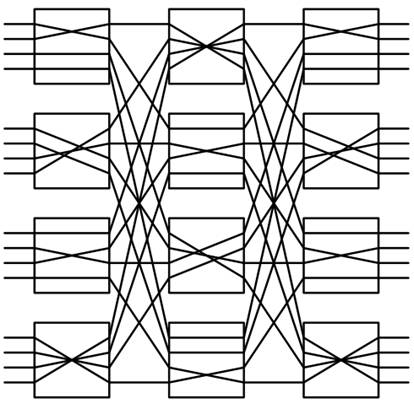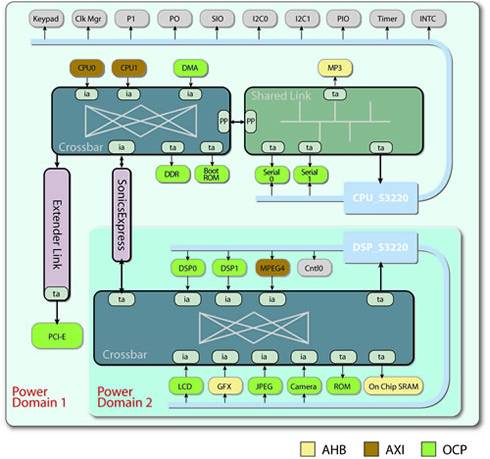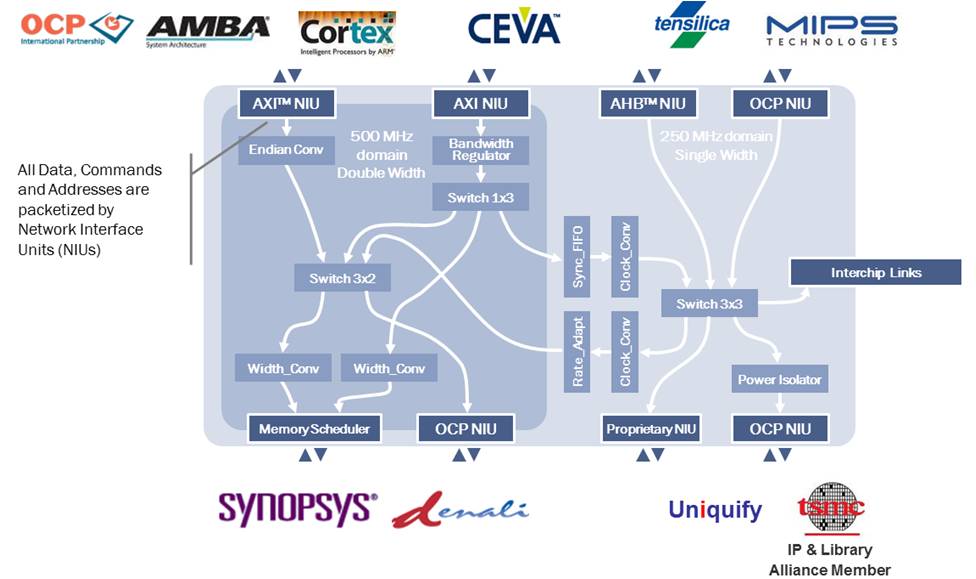The text of this very first article about Arteris had disapeared from Semiwiki, for an absolutely unknowed reason…If you have missed it, this is a pretty useful introduction to NoC concept, as well as to the legal battle between Arteris and Sonics:
The Network on Chip is a pretty recent concept. Let’s try to understand how it works. Anybody who has been involved in the Supercomputer design (like I was in the 80’s), knows that you need a “piece” between the multiple CPU and memory banks, at that time a “crossbar switch”. To make it outrageously simple, you want to interconnect the M blocks on the left side with the N blocks on the right side, to do so you create a switch made of MxN wires.

The “crossbar switch” is as old as the phone industry! Would this type of architecture be implemented in a multimillion gates System on Chip, you easily can guess the kind of issues generated: routing congestion, too long wires, increasing delay and power consumption due to interconnects. Thanks to the modern telecommunication, the “old” way to build networks has been replaced by “bit-packet switching over multiplexed links”. This simply means you can use a single physical link to support several functional interconnect, and that you apply the packet transport approach, very popular in the new interface protocol like PCI Express for example, serialized to again reduce the number of wires. The NoC concept was born in the early 2000’s and the first dedicated research symposium on Networks on Chip was held at Princeton University, in May 2007.
Let’s come back to the fight of the day, on my left Sonics, fighting with Arteris, on my right. Sonics has been founded in 1996, it’s important to mention it, as it was very early in the NoC history. The first product launched by Sonics, like the Synapse 3220, was based on “crossbar switch” topology and the “significant benefit”, according with Sonics here was “its control of the interconnects power dissipation. In a classic bus-based architecture, during any given transaction, all of the wires in the bus are driven, not just those from a given initiator to a given target. This wastes a significant amount of power. Synapse 3220 addresses the problem by activating only the required segment of the interconnect for a given transaction, while the rest is kept deactivated.” As you can see, the product was not packet based, neither multiplexed, nor serialized – it was a crossbar switch where you could deactivate the busses not used in a given transaction. If we look at the NoC product released in 2005 (Arteris was created in 2003), like the SonicsMX, it was still based on “crossbar switch” (just look at the dark blue blocks):

When Sonics came on the market, they were alone on a niche, enjoy many design win and grow their customer base. And they had to keep their legacy interface (based on OCP for example) to satisfy the existing customers when developing new products. When Arteris start business (in the mid 2000’s), they jump to the most effective, modern NoC topology: “point-to-point connections rather than the more typical mixture of multiple fan-out meshes. While a more standard hybrid bus will contain a centralized crossbar and numerous wires that create difficult-to-route congestion points, an NoC’s distributed communication architecture minimizes routing congestion points to simplify the chip’s layout effort”.

What was the market answer? In 2005, Sonics was still enjoying prestigious design win for NoC at many application processor chip makers for the consumer or wireless handset market (“Broadcom, Texas Instruments, Toshiba Corp., Samsung and several unnamed Original Equipment Manufacturers”). That we see today is that Arteris’ customer list includes: Qualcomm, Texas Instruments, Toshiba, Samsung… and also LG, Pixelworks or Megachip! There is nothing like customer design win to quantify an IP product success.
So, I don’t know if Sonics’ patent can be applied to Arteris’ NoC IP (I am not a lawyer, neither a NoC expert), but that I can see is that Sonics came very early on the NoC IP market, using a “crossbar switch” topology and has enjoyed a good success on a niche market… where it was the single player. About 10 years later, Arteris came to the same niche, but rich, market (complex SoC for application processor for wireless handset, or multimedia processors) with a more innovative product (see above) and win pretty quickly (5 years is quick to design-in a new concept) majors IDM or ODM sockets… If your product is not good enough, is it time to go to legal? I don’t say it’s the case, but it look like it is!
Eric Esteve fom IPNEST
Share this post via:






Comments
0 Replies to “Arteris vs Sonics battle…Let’s talk NoC architecture”
You must register or log in to view/post comments.